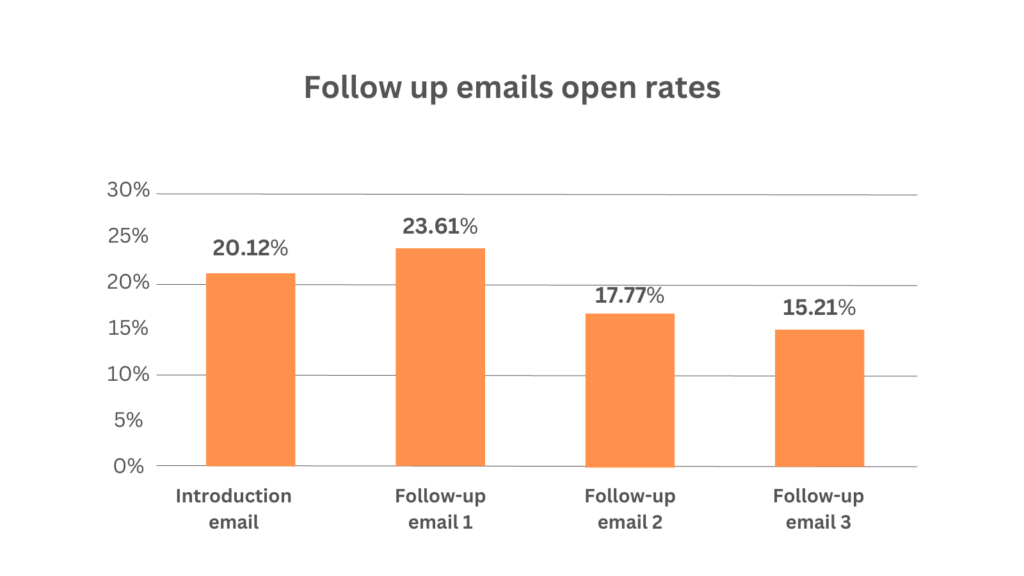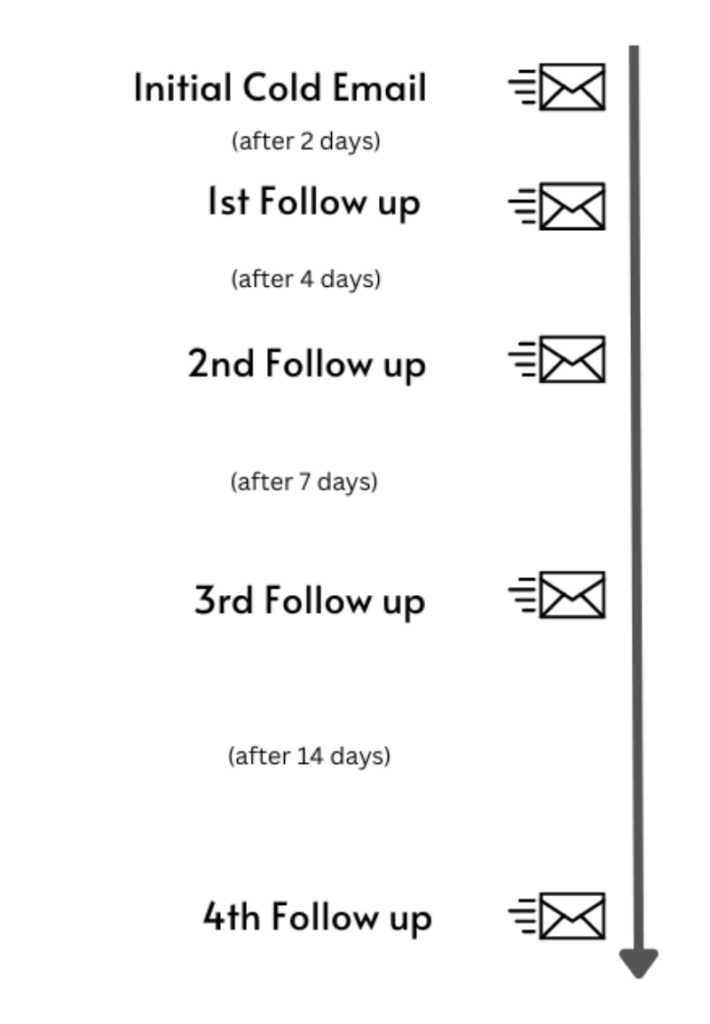Email has become the backbone of communication. However, what happens when your well-crafted initial email receives no response? So, is it time to give up?
Not yet! Better send a follow-up email.
In this post, we’ll explore how you can follow up on email after no response, why sending a follow-up after no response is crucial, and provide some follow-up email templates after no response.
Table of contents
1.Why to follow up on email after no response?
2. How to write a follow up email after no response?
3. Follow-up email after no response examples
3.1 Networking Event Follow-Up
3.2 Job Application Follow-Up
3.3 Sales or Business Proposal Follow-Up
3.4 Collaboration Opportunity Follow-Up
3.5 Follow-up email after a free-trial
4. Following Up After No Response: Mistakes to avoid
5. Conclusion
Why to follow up on email after no response?
When your initial email lands in a busy inbox, it will be competing for attention alongside numerous other messages.
So, a lack of response doesn’t necessarily mean disinterest; it could be due to a variety of reasons like a hectic schedule, accidental oversight, or a flooded inbox.
Sending a follow-up email showcases your persistence and genuine interest, often prompting recipients to revisit your initial message.
Look at the follow follow-up email open rates from Leadsquared:

It’s a chance to remind them gently without being pushy, proving that your communication matters.
How to write a follow up email after no response?
Creating a compelling follow-up email requires finesse and strategy. Here’s a step-by-step guide to help you craft a follow-up that stands out:
Subject Line Reinvention:
Start with a subject line that captures attention without sounding pushy. A creative approach or a friendly tone can intrigue recipients to open the email.
Reference Your Previous Email:
Begin by referencing your initial email to refresh the recipient’s memory. Keep it concise and friendly.
Highlight Value:
Remind them of the value your proposal, product, or idea brings to the table. Emphasize how it addresses their needs or challenges.
Call to Action:
Include a clear and specific call to action. Whether it’s scheduling a call, requesting feedback, or sharing additional resources, make it easy for them to respond.
Polite Persistence:
Use courteous language that conveys your respect for their time. Express that you understand they’re busy and acknowledge any potential reasons for their lack of response.
Concise Format:
Keep your follow-up email succinct. Short paragraphs and bullet points can make it easier to skim through.
Follow-up email after no response examples
Before diving into the templates make sure that you craft outstanding follow-up email subject lines.
1. Networking Event Follow-Up
At the technology trends conference, you had a captivating conversation, a fellow attendee. You discussed the integration of AI in healthcare and exchanged contact information.
Despite your initial follow-up email, you haven’t received any response. It’s been a week since the event, and you’re motivated to continue the dialogue.
Reminder email for no response sample:
 |
| Subject: Continuing Our Conversation from #Event Name# |
| Hi #Name#, I hope this email finds you well. It was wonderful meeting you at #Event Name#. Our discussion about #Topic# truly resonated with me. I wanted to follow up on the points we touched upon and share an insightful article I came across: #Link to Article#. I believe you’ll find it valuable given our conversation. Your thoughts on this would be highly appreciated. If your schedule allows, I’d love to schedule a call to delve deeper into our potential collaboration. Wishing you a fantastic day ahead! Regards, #Signature# |
 |
2. Job Application Follow-Up
You have applied for the Digital Marketing Specialist position at the marketing agency. You went through a promising initial interview, but it’s been two weeks since you last heard from them.
Feeling enthusiastic about the opportunity, you decide to reach out again to express your continued interest in the position and seek clarity on the current stage of the hiring process.
No response after interview follow up email sample:
 |
| Subject: Revisiting My Application for #Position# |
| Hi #Name#, I hope this email finds you well. I wanted to kindly follow up regarding my application for the #Position# at #Company Name#. I’m truly excited about the possibility of contributing my #Relevant Skill# expertise to your team. To provide further context, I’ve attached a portfolio showcasing my recent projects, which I believe align with #Company’s Goals or Culture#. If there’s any additional information you require or steps I should take, please do let me know. Your feedback is incredibly valuable to me. Thank you for your time and consideration. Regards, #Signature# |
 |
3. Sales or Business Proposal Follow-Up
You sent a comprehensive proposal to a potential client, a finance startup, detailing how your software can enhance their financial processes and customer engagement. They had shown interest but haven’t responded after receiving the proposal.
With the aim of keeping the conversation alive, you’re sending a follow-up email to remind the potential client of the benefits your solution can provide and how it aligns with their needs.
Here’s a sales follow up email after no response:
 |
| Subject: Elevating Your #Problem# with #Your Solution# |
| Hi #Name#, I trust this email finds you well. I’m circling back to discuss the #Your Product/Service# proposal I sent your way last week. In addition to the proposal, I’ve attached a case study detailing how #Your Solution# helped a similar company overcome #Similar Problem#. I thought this might provide valuable insights for your situation. I’m eager to hear your thoughts on this and whether you see potential synergies. If you have any questions or need further details, please don’t hesitate to reach out. Thank you for considering #Your Company# as a partner. Regards, #Signature# |
 |
4. Collaboration Opportunity Follow-Up
You met Sarah, the founder of a local sustainability initiative, at a community event. You discussed various ideas for collaborating on promoting eco-friendly practices in your town.
Eager to progress and excited about the potential collaboration, you decide to send a follow-up email to explore ways to move forward and continue discussing the impactful initiatives you brainstormed together.
Follow up email after no response template:
 |
| Subject: Exploring #Project/Initiative# Collaboration |
| Hi #Name#, I hope this message finds you in good spirits. I wanted to revisit our conversation about potential collaboration on #Project/Initiative#. To add further value, I’ve compiled a brief presentation outlining the potential outcomes and benefits of our partnership. You can find it here: #Link to Presentation#. Your input on this would be truly invaluable. If your schedule permits, let’s arrange a quick call to discuss our next steps and align our efforts. Thank you for considering this exciting venture. Regards, #Signature# |
 |
5. Follow-up email after a free-trial
You offer a software solution for project management. A prospect has signed up for a free trial of your software a week ago, but he hasn’t engaged with the software or responded to your initial welcome email.
Here’s a sample follow up email after no response from client:
 |
| Subject: Your Project Management Software Trial – Let’s Get Started! |
| Hi #Name#, Hope you’re well. I noticed you signed up for our project management software trial last week. Haven’t seen much activity yet. Is there anything I can help with? We’re here to make your trial experience smooth and productive. Let me know if you have questions or need assistance. Looking forward to helping you succeed! Regards, #Signature# |
 |
Following Up After No Response: Mistakes to avoid
While follow-up emails can be powerful tools to re-engage with your recipients, there are a few common mistakes you should be cautious of.
Being Overly Persistent
While follow-up emails are meant to remind recipients, bombarding them with frequent messages can have the opposite effect. Hence, it’s essential to give the recipient adequate time to respond. Sending a follow-up too soon after the initial email might not give them enough time to address their priorities or consider your proposal. Here’s a chart that can help you:

Refer to our post on when to send a follow-up email for more clarity.
Neglecting Personalization
Sending generic follow-ups without any reference to the previous conversation can give the impression that you’re sending mass emails without considering the recipient’s needs or interests. Hence, personalization is a must.
Using Aggressive Language
Employing overly assertive or aggressive language can create tension and discourage the recipient from responding. Maintain a polite and respectful tone throughout your communication.
Not Providing Value
Every follow-up should offer something valuable to the recipient, whether it’s a relevant article, a solution to a problem, or an update related to the previous conversation. Simply asking for a response without offering value reduces the incentive to engage.
Neglecting Clarity
A follow-up email should clearly state your intention and what you’re hoping to achieve. Ambiguity can confuse the recipient and decrease the likelihood of a response.
Skipping the Call to Action
A clear call to action is crucial in a follow-up email. If you don’t explicitly guide the recipient on how to respond or what you’re looking for, they might hesitate or neglect to reply.
By avoiding these common mistakes, you can increase the chances of crafting follow-up emails that leave a positive impression, encourage responses, and contribute to building meaningful connections.
You can use the above-mentioned follow-up email after no response templates directly. Tailor them as per your preferences.
Conclusion
Sending a follow-up email after no response isn’t a sign of desperation; it’s a strategic move to keep the conversation alive. By applying the steps outlined above, you can create follow-up emails that resonate with recipients and yield higher response rates.
Remember, persistence paired with a respectful approach can pave the way to building meaningful connections and achieving your goals in the realm of email communication.

Leave a Reply